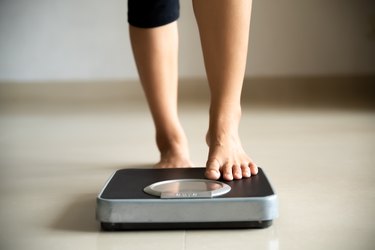
Whatever your motivation for wanting to lose 20 pounds in one month (say, a looming wedding, family event or graduation), unless you're on a medically prescribed plan, this rate of weight loss is nearly impossible and unsafe to achieve in just 30 days.
However, a month does give you time to lose some weight. And, more importantly, during that time you can jump-start healthy habits that'll help you continue to slim down in the coming weeks. Here's how to get started.
Video of the Day
Video of the Day
Establish Realistic Weight-Loss Goals
To lose weight, you need to create a calorie deficit, which is when you burn more calories than you eat, according to the Mayo Clinic. In order to establish a realistic goal for one month of weight loss, consider how many calories you eat to maintain your current weight (your maintenance calories).
You can find your maintenance level by tracking your meals for about a week, monitoring how many calories you eat each day. Then, assuming you don't gain any weight during this week, you can use this general value as your calorie baseline.
In order to lose 1 to 2 pounds per week, which is generally considered a safe weight-loss goal, you need to cut between 500 and 1,000 calories per day, according to the Mayo Clinic. Creating a calorie deficit to lose 20 pounds in one month, on the other hand, entails a drastic, unsustainable diet plan, which can be risky to your health and may cause nutritional deficiencies.
Also, once you return to eating as you were before your effort to lose 20 pounds in a month, you'll likely gain the weight back quickly. Instead, do what you can to set up long-term healthy habits that will help you lose weight and keep it off for life.
Create a Healthy Calorie Deficit
A healthy, sustainable rate of weight loss is 1 to 2 pounds per week.
When you first start a diet plan and make drastic changes in the way you eat and exercise, you may lose more weight initially in the form of water. This rapid weight loss should level off after a couple of weeks, however.
A calorie deficit of 500 to 1,000 calories per day will help you lose between 4 and 8 pounds safely in one month. So, assuming you continue with this same rate of weight loss, you can expect to lose your goal of 20 pounds in about 2 1/2 months.
Use your calorie tracker to monitor your daily intake and deduct between 500 to 1,000 calories each day. If that puts you below the minimum recommended 1,600 calories for a woman or 2,000 calories for a man, try a less drastic calorie deficit and introduce a little more exercise to your daily routine, according to the USDA Dietary Guidelines.
Related Reading
Plan Meals to Lose 20 Pounds
If you want to see the best possible results within a 30-day period, limit your consumption of processed foods, which are often high in calories but low in nutrients. Regularly eating ultra-processed foods can lead to overconsumption, potentially adding as much as 500 calories to your daily intake, according to a May 2019 study published in Cell Metabolism.
Instead of packaged foods such as snack crackers, cereal bars and soda, eat plenty of lean protein at each meal to ward off hunger, recommends the Academy of Nutrition and Dietetics.
Fill up on fiber-filled veggies and fruit, but limit the dressings, sauces and butter you use to flavor these foods. Use citrus juice, vinegar, fresh herbs, spices and sparse amounts of olive oil to add zest.
Make sure to select snacks that are high in nutrients but low in calories. Quality snacks that can support your quest to lose 20 pounds include:
- Fresh fruit
- A handful of nuts
- Low-fat cheese
- Low-fat yogurt
With some clever thinking, you can find ways to add plenty of volume to your meals.
Related Reading
Augment Weight Loss With Exercise
Increasing your physical activity levels will help you lose weight more quickly and keep it off in the long run. If you don't already exercise, use the month to work toward at least 150 minutes per week of moderate-intensity cardiovascular activities, such as brisk walking or water aerobics, according to the U.S. Department of Health and Human Services (HHS).
Implement a consistent strength-training regimen to maximize your weight loss. If you're new to this type of exercise, the HHS recommends two or more days of weight training per week. Building more muscle in your body will improve your metabolism and therefore increase the amount of calories your body burns in a day, according to the Mayo Clinic.
With every workout, aim for at least one exercise that hits every major muscle group — including the chest, arms, back, abs, hips, legs and shoulders — with a minimum of one set of 6 to 12 repetitions, according to the National Academy of Sports Medicine (NASM). For more guidance on creating a resistance-training program, talk to a fitness professional.
Related Reading
- Mayo Clinic: "Counting calories: Get back to weight-loss basics"
- USDA: "Appendix 2. Estimated Calorie Needs per Day, by Age, Sex, and Physical Activity Level"
- Cell Metabolism: "Ultra-Processed Diets Cause Excess Calorie Intake and Weight Gain: An Inpatient Randomized Controlled Trial of Ad Libitum Food Intake"
- Academy of Nutrition and Dietetics: "Essential Nutrients for Women while Managing their Weight"
- U.S. Department of Health and Human Services: "Physical Activity Guidelines for Americans"
- Mayo Clinic: "Metabolism and weight loss: How you burn calories"
- NASM: "Back to the Basics: Hypertrophy"